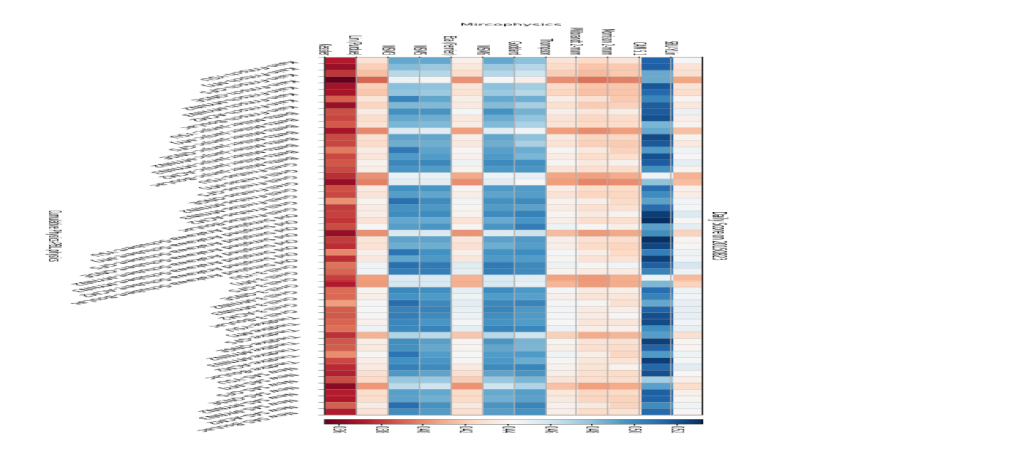Scientific Leader: Garrett Good
The increasing contribution of variable weather dependent renewable energy sources (RES) to the electricity grids of European countries challenges the existing energy system in many ways. Power grid and plant management as well as power stock exchange trading are the two major areas affected by insufficiently predicted wind and solar power.
Weather forecasts play a huge role in decision-making, and the most costly situations for all stakeholders are those extreme weather events missed by conventional forecasts, like stormy winds producing excess wind power or unexpected fog blocking all photovoltaic feed-in. Even probabilistic modern forecasts that simulate tens of possible scenarios can miss these events entirely.
Ultra-large ensemble sizes of O (1000) model runs can address the challenge of capturing all events using continuous probabilistic short-term forecasts, yielding probability density functions (pdfs) for wind and clouds respectively. At sufficient (1km) resolution, this ultimately requires exascale computing capability, which in turn means addressing a series of technical challenges, particularly in the areas of ensemble modelling, programming models, and big data analytics.
The flagship framework for accommodating these innovations will be the Ensemble for Stochastic Interpolation of Atmospheric Simulations (ESIAS), which will initially include the Weather Research and Forecast (WRF) model adopted to predict winds at rotor hub heights and cloud optical thickness (COT). The EURopean Air pollution Dispersion-Inverse Model (EURAD-IM) will further address the impact of aerosol-induced turbidity on solar power production. These tools will provide the meteorological data needed for wind and solar day-ahead power forecasting, as well as for short-term forecasting in confluence with satellite-based cloud-motion solvers.
Primary codes
ESIAS-Chem is a tool for generating and controlling ultra-large ensembles of chemistry transport
models for stochastic integration, exploiting a two-level parallelism, combined
with a particle filter data assimilation scheme.
ESIAS-Meteo is a tool for generating and controlling ultra-large ensembles of numerical weather
forecast models for stochastic integration, exploiting a two-level parallelism,
combined with a particle filter data assimilation scheme.
EURAD–IM (Current forecasts can be viewed here ) simulates chemistry particle transportation in local atmospheres coupled
with a weather forecast application WRF. An advection-diffusion-reaction
equation, with multiple solvers for chemistry, is used.
ESIAS ensemble run part will be entirely refactored with proposed technologies in EoCoE-II.
Secondary Codes
The Wind
Power Management System (WPMS), see Vogt et al., and the Solar Prediction
System (SPS), Saint-Drenan et al. are empirical and physical wind and solar
power models used at Fraunhofer IEE to calculate German power forecasts from
meteorological forecasts and satellite measurements.
Large-Scale Optimization of the Weather Research Forecasting Model
In order to capture all possible scenarios, one must properly model the underlying meteorology. Numerical weather forecasts consist of many underlying physical schemes and parameterizations based e.g. on typical conditions in the region of the model provider. Problems in the physical modelling can express themselves through an overall bias in the wind or COT output or in unrepresentative differences between scenarios due to the various models’ sensitivities to perturbations of the initial condition. While post-processing techniques will improve the distribution in Meteo for Energy, the quality of the input is decisive.
In EoCoE II, we have conducted large-scale tests of an unprecedented 672 combination of WRF schemes for 12 simulated days, summarized for wind and solar in figure 1. We have verified the wind data against 1172 ground stations at the two-meter level, and the cloud coverage against satellite data [83].
For the physical scheme, PBL physics most affected the hourly wind speed, while the Mellor-Yamada-Nakanishi-Niino scheme (MYNN2 and MYNN3) and Asymmetric Convective Model (ACM2) performed best. For the microphysical scheme, CAM5.1, WSM3/5/6 and Goddard best detailed the cloud coverage (radiation schemes not shown here). CAM5.1 is the most accurate, but takes longer to simulate than the others. Among the faster schemes, Goddard appeared to be better in the later spring and early autumn. Finally, the cumulative schemes Tiedtke, Grell-3, and Simplied Arakawa-Schubert all achieved good scores with above-mentioned microphysics.
These results should be broadly useful to meteorological research in Europe using WRF, while in Meteo for Energy making the ultra-large ensembles of wind and photovoltaic power forecasts comparable to actual meter data.


Figure 1: Ten-meter hourly wind speed score (top/right) on 2015-08-23 and cloud matching rate score (i.e., index of agreement [49]).
Post-Processing Solar Irradiation for PV
While a proper selection of schemes in WRF will provide a better basis, evee operational numerical weather predictions (NWP) can have very biased downward solar irradiation. It is both very difficult to model and has not had the attention of more broadly important variables in weather forecasting like wind,
temperature, or precipitation.
We have developed an effective calibration scheme for the irradiation data used in the solar power conversion model. Rather than correcting for bias only at the end of the forecast chain, comparing solar power calculations to German PV data, we use local satellite irradiance measurements to calibrate the solar input. This bias correction is possible local to each pixel of the high-resolution satellite images, identifying differences due e.g. to local topography not resolved by the weather model. While a correction of the aggregated German power works well on average, this correction does not differentiate local weather conditions across Germany, which we hope to capture with our O(1000) ensemble members. Figure 2 shows a calibration scaling based on one year, where each pixel is independently calibrated. The spatial correlation of the scaling indicates some robustness and apparent correlation between topography and NWP bias.
We have so far been able to test this approach on operational day-ahead numerical weather forecasts, where we achieved a significant improvement in the root-mean-squared error between the raw power forecast and the German electric meter data from 3.5 to 3.2%.

Figure 2: Calibration scaling (left) of the input weather model to satellite irradiation; Comparison to German topography (right).
A hybrid physical and machine learning based forecast of regional wind power. S. Vogt, J. Dobschinski, T. Kanefendt, S. Otterson, and Y.M. Saint-Drenan in Fraunhofer IWES, 2016.
A probabilistic approach to the estimation of regional photovoltaic power production.
Y.M. Saint-Drenan, G. H. Good, and M. Braun in Solar Energy, 147:257-276, 2017.
ESIAS-chem:
Quantitative estimation of unexpected emissions in the atmosphere by stochastic inversion techniques,
PHD Thesis Philipp Franke, 2018, Univ. of Cologne (http://kups.ub.uni-koeln.de/id/eprint/8437)
ESIAS-meteo:
PHD Thesis Jonas Berndt, 2018, Univ. of Cologne (https://kups.ub.uni-koeln.de/9098/)
EURAD-IM:
Emission rate and chemical state estimation by 4-dimensional variational inversion
Elbern, H., Strunk, A., Schmidt, H., and Talagrand, O. in Atmos. Chem. Phys., 7, 3749-3769, 2007.
https://doi.org/10.5194/acp-7-3749-2007
Elbern, H. and Schmidt, H: A four – dimensional variational chemistry data assimilation scheme for Eulerian chemistry transport modeling, J. Geophys. Res., 104, 18583 – 18598, 1999
